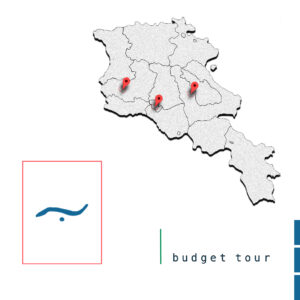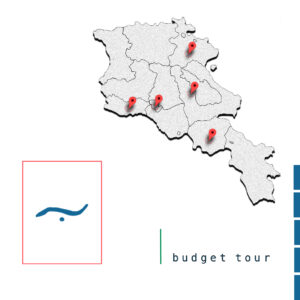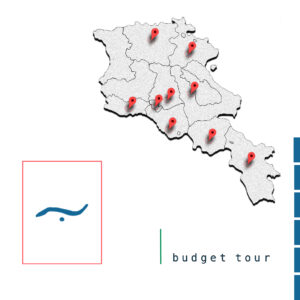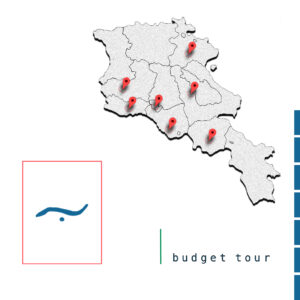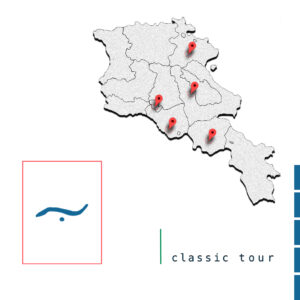The Matenadaran, officially the Mesrop Mashtots Institute of Ancient Manuscripts, is a museum, repository of manuscripts, and a research institute in Yerevan, Armenia. It is the world’s largest repository of Armenian manuscripts.
The Matenadaran museum is located in the institute’s old, original building. What was previously a single presentation gallery now consists of fifteen halls in which thousands of temporary, changeable and sole exhibits are on display. Manuscript, pieces of manuscript, documents, old books, special bindings, unique miniatures, and more are shown from the Matenadaran’s database of roughly 23,000 manuscripts.
The exhibition hall has been opened only in one hall in 1957 after the fulfillment of the main Matenadaran construction. The exhibition halls grew in number after the construction of the new Matenadaran facilities in 2011 (where the scientific departments moved), and the main building was largely assigned to the exhibition halls, as well as offices, restoration laboratories, and strategically maintained repositories.
The exhibition of the Main hall is committed to the evolution of Armenian medieval sciences, literature, and arts throughout the centuries. It follows Armenian culture since the creation of the Armenian alphabet by Mesrop Mashtots in 405 AD until the 18th century. It presents old Armenian translations and works of all spheres of medieval science and art (history, philosophy, exact sciences, cosmology, medicine, literature, etc.), donations, as well as medieval Armenian miniature painting and specimens of medieval bindings. The arrangement of this hall has been completed by the instances of the survived manuscripts from the Genocide. The Artsakh exhibition hall keeps miniature pieces of the Artsakh School, with its creative specificity and distinguishable features.
Later, miniature painting from the Schools of Bardzr Haik (Upper Armenia), Cilician Armenia, the Crimea, Constantinople, and others will also be displayed.
In the manuscript collection hall of Mush and Karin are shown also survived manuscripts from Armenian other areas. The most notable of those manuscripts are Msho Charentir (Homilies of Mush) (led the first half of Homilies of Mush), Zeytun Gospel, small manuscripts of Cilician School (School of Toros Roslin). The exhibition also has digital copies of multiple manuscripts shown on displays on the wall.
In the hall of Vaspourakan’s manuscript exhibition guests are introduced to the survived manuscripts which belong to the Schools of Van and Vaspourakan. There are shown the Dashunahar Gospel, Hrashagorts Gospel, “The Book of Lamentations” of St. Gregory of Narek, the granted manuscripts to the Matenadaran by the president of the Republic of Armenia. There are shown near the hall through images of the activities of Catholicos of All Armenians Gevorg V and the committees sent to Western Armenia.
In the Medieval Medicine exhibition gallery, visitors can admire the manuscript’s medical texts which have not only historical and theoretical but also contemporary and functional significance. In the Medieval Armenian Medicine laboratory of the Matenadaran, experts use “cochineal” worms and fragrant plants and roots, that grow only in the Armenian Highland, to prepare wholesome “Royal Balm,” floral teas, and rejuvenating skin oils used by “noble women” in the Middle Ages. These things are impressive souvenirs that are sold only in the Matenadaran; they are prepared according to medieval recipes. There are also displayed ingredients used to create natural dyes and the Holy Myrrh.
The Map’s hall shows maps reprinted from Medieval Armenian, Latin, Greek, Arabic, and other manuscripts that depict the antique world and medieval geographical knowledge. The first map printed in Armenian is also shown (Amsterdam, 1695).
The exhibition of Archival valuable records kept in the Matenadaran is devoted to the 100th anniversary of the Armenian Genocide in which are included samples exhibited for the first time. The visitors have an chance to see the derelict property confiscation orders of Armenians, the photos of actions of Echmiadzin orphanage and Hovhannes Tumanyan, the registers of Armenian Prelacy of Adana, and the photos of Aintab battle, etc.
The Matenadaran’s archival records collection was based on the Echmiadzin Catholicosate and was subsequently enhanced by numerous donations. The number of documents now exceeds 500,000.
In the two halls of Old printed books are displayed Armenian and foreign important and occasional books published in various countries and cities (Venice, Amsterdam, Constantinople, New Julfa, Paris, Marseille, Lvov, Madras, Rome, Moscow, Astrakhan, St. Petersburg, and elsewhere) during the 16th -18th centuries. The first Armenian books were printed in Venice in 1512-1513, by Hakop Meghapart.
In the framework of collections of the 100th anniversary of the Armenian Genocide in the Virtual hall of the Matenadaran one can watch a documentary film about “Kemalist massacres” based on the Matenadaran’s archival documents.
In the four exhibition halls allocated for M. Saryan’s work tourists may catch the master’s most notable creations of art from his early works to his last oil artwork “Fairy Tale”. The galleries also show creations from the Egyptian region, “Walking Woman,” “Night Landscape,” Saryan’s book illustrations (V. Bryusov’s “Anthology of Armenian Poetry,” 1916, etc.), and some items of Saryan’s personal belongings, as an Egyptian mask and so on.
5 interesting facts about Matenadaran
Plan your visit to Matenadaran and a wealth of other attractions in Armenia, well-known and undiscovered, using our tour itinerary planning tool. We can design a complete itinerary for you including suggestions of our favourite places and things to see. We’ll book all your accommodation and transport, and of course we’ll drive you anywhere you like along the way.

Let's work together
Ready to build something special? Hire a trip designer now!
Utravel Adventures and Tours
Trips led by local experts—activities, meals, and stays included.
Explore attractions and more near Matenadaran
What to do in Yerevan
